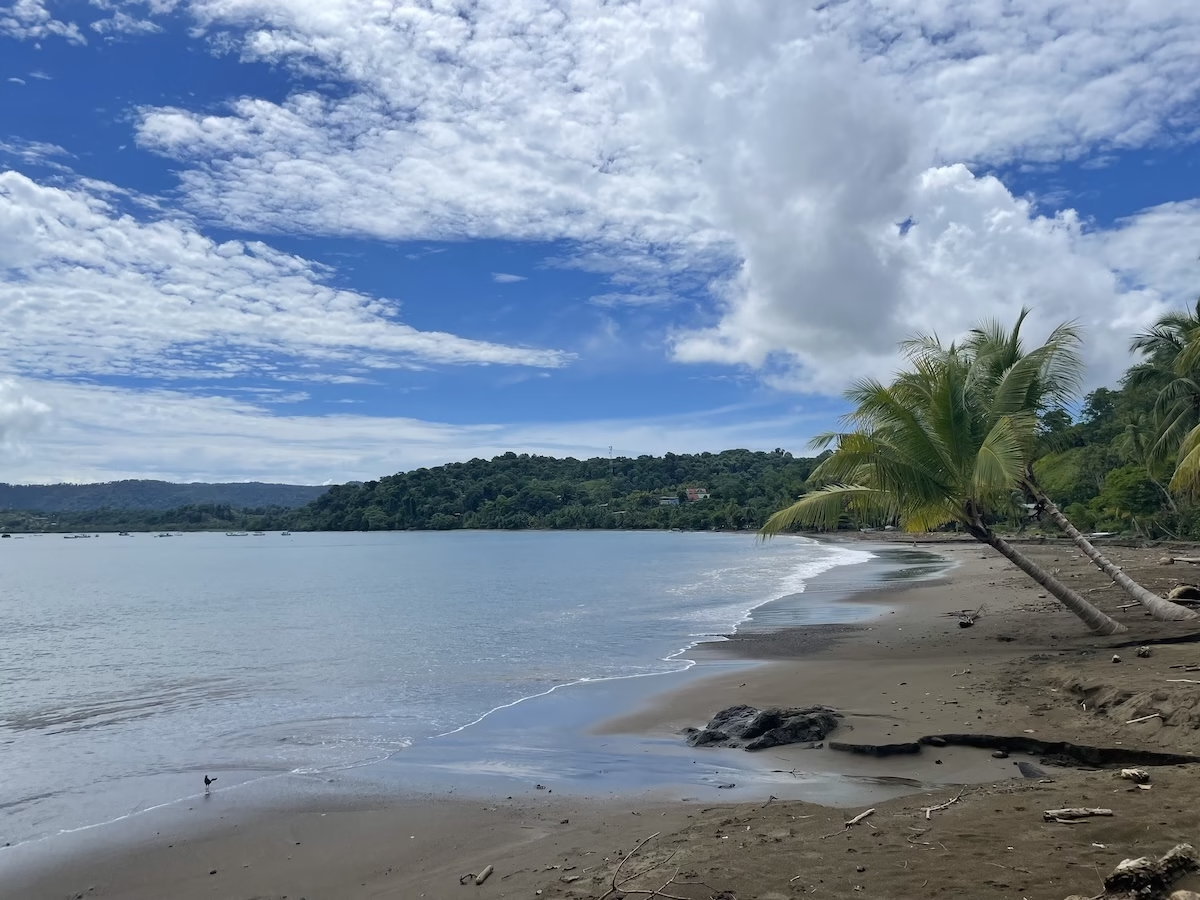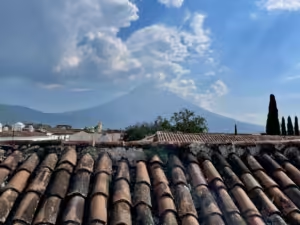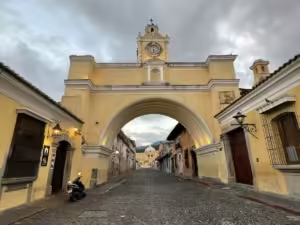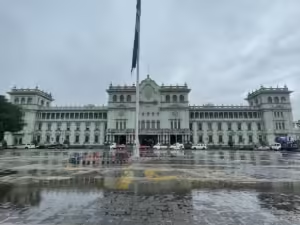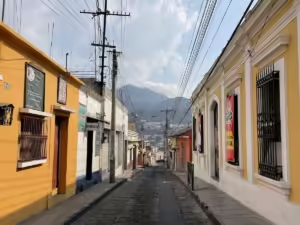Drake Bay is a small town on the shores of Costa Rica’s magnificent Osa Peninsula, and I absolutely loved it. I loved the muddy roads that climb up from the beach past ramshackle tourist restaurants and palm trees full of nesting scarlet macaws. I loved the outstanding Corcovado National Park, where you can see tapirs, monkeys, snakes, anteaters and more.
I wasn’t as in love with the two times we almost died. Once during a surprise thunder storm on the boat ride into town. Later we faced down a troop of angry monkeys. Okay so maybe the monkeys probably weren’t going to kill us, but you never know. It was still scary.
However, I do love that there’s a place in super touristed Costa Rica that’s still wild enough to have scary adventures. You most likely won’t have to deal with storms or monkey attacks, but you’ll definitely have a great time visiting the Osa Peninsula.
What to Know about Drake Bay and the Osa Peninsula
The Osa Peninsula is in the far southeast of Costa Rica, near-ish the border with Panama. Corcovado National Park covers the majority of the peninsula. The park is Costa Rica’s largest and is teeming with all sorts of wild life. It protects some of the world’s last remaining lowland tropical forest and contains 2.5% of the world’s biodiversity. That’s a lot considering it’s a relatively small area.
There are two main settlements on the Osa Peninsula: Drake Bay and Puerto Jimenez. I can’t speak personally about Puerto Jimenez, but it’s connected to the rest of Costa Rica by road and has amenities like ATMs and nightlife. Drake Bay, however, is only reachable by boat or dirt roads that are often washed out in the rainy season. It really feels like the end of the world.
Drake Bay was named after Sir Francis Drake, the worldly explorer or dastardly pirate depending on who you ask, who used to use the bay as a hideout. Rumor has it that he buried some treasure in the area. Today, Drake Bay is a touristy, but very calm, little settlement. The roads are muddy and aside from some resorts outside of town, everything has a decidedly un-fancy, run down appeal. The real treasure is the abundant nature surrounding the town.
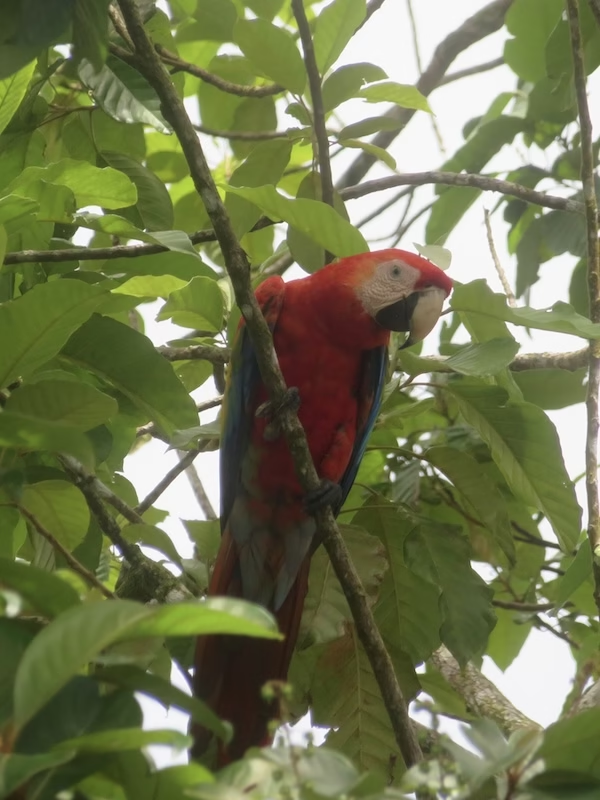
How to Get to Drake Bay
Drake Bay is not an easy place to travel to. This annoys some people, but I think it adds to the place’s charm. It’s an adventure just to get there.
Of course, you can fly, but that’s expensive and boring. Taking the bus and boat is not only cheaper, but it’s a great experience in and of itself. This option takes a long time, but was surprisingly easier than expected.
All boats to Drake Bay leave from a little coastal town called Sierpe. I believe boats leave at 11am and 4 in the afternoon, but you should double check this with your accommodation in Drake Bay before you set out. Some direct buses go direct from San José to Sierpe, otherwise you’ll need to transfer in Palmar Norte. You can get a local bus if the times match up. We caught a taxi and I don’t regret it.
You can make it to Palmar Norte from Uvita, Quepos or any number of towns along the Pacific Coast. If you’re coming from San José, head to the Tracopa terminal. If you want to make the early boat, you’ll need to catch the very first bus at like 5am. The whole journey takes about 6 hours.
We split things up and stayed the night in Uvita. It was awful. Maybe you can find another little Pacific coast town that isn’t as much of a gringo settler colony.
Anyway, to sum up… from San José use the Tracopa terminal and catch a bus to Palmar Norte. From Palmar Norte, take a bus or taxi to Sierpe. From Sierpe, hop on the boat to Drake Bay.
On a side note, the road to Palmar Norte passes through miles and miles of palm oil plantations. I was a little perturbed to see this, especially in a place like Costa Rica that’s known for its eco-friendly policies. Palm oil is terrible for the environment. You can read more about it here. I guess even Costa Rica has to balance protecting its environment and keeping up with development in the global capitalist economy.
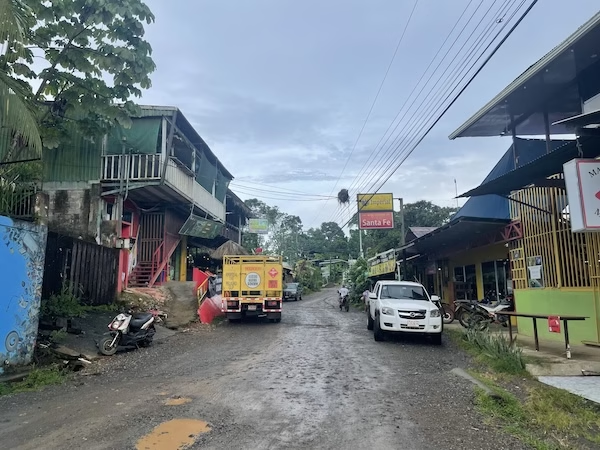
The Boat Ride Where We Almost Died
On a normal day, the boat ride from Sierpe to Drake Bay is a lovely one. You cruise down the river from the docks, passing lush tropical forest as your gives you a brief introduction to the area. It started out that way for our small group; my wife and I, some college-aged kids from Colorado and an older Costa Rican couple. We were all laughing and joking until we left the comfort of the river and into the open waters of the bay. There the dark clouds began to gather on the horizon. Literally.
It started raining, and we all scrambled to shove our bags into the tiny hold at the front of the boat. The captain passed out thin plastic ponchos. We were wet, but still in good spirits.
Then, a dark cloud passed over the captain’s face (figuratively) and the once jovial man turned unnervingly serious.
I should mention that our boat wasn’t very big. There were eight of us, plus the captain and his assistant, crammed into a small fiberglass tub that felt much smaller when faced with the full wrath of an angry Pacific Ocean.
Streaks of lighting flashed across the sky. Thunder crashed all around us. Waves lifted our tiny fiberglass tub into the air and slammed us back down onto the surface of the ocean. One of the college-aged kids from Colorado started crying. The Costa Rican woman began praying behind us. My wife and I held hands. All of us crouched down in our seats, trying to press ourselves as far as we could to the bottom of the boat, hoping that tiny fiberglass tub could protect us.
The captain and his assistant, thankfully, knew what they were doing. They steered the boat between the waves, and angled the bow in just the right way so the waves didn’t capsize us. The whole ordeal probably didn’t take that long, but it felt like forever. I don’t know if the storm passed by or we just plowed through it. When we finally landed on the beach at Drake Bay, I wanted to drop down and kiss the sand like they do in the cartoons.
Don’t let any of the above put you off of visiting Drake Bay. Just take it as a reminder to always wear your life jacket.
I have some more thoughts about safety and crime in Central and South America. Read them here: Rethinking Travel Safety and Crime in Latin America
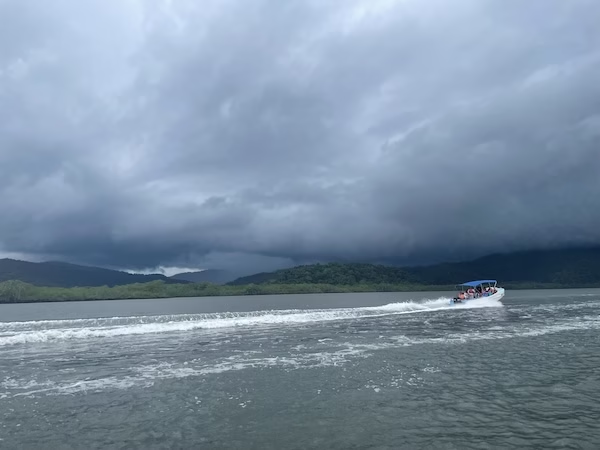
Where to Stay in Drake Bay
Once we were safely on land, we were met by a representative of our hostel. I’d like to take this opportunity to whole heartedly recommend Casa Jade in Drake Bay. This lovely little hostel is located up on top of the hill, and parts of it have a fantastic view looking out over the bay. There’s also a kitchen and tour desk to organize all your Osa Peninsula adventures.
There are dorms and single rooms, but I’d recommend splurging on a private bungalow. Also, in the evenings we saw a flock of scarlet macaws and toucans roosting in the trees just outside our bungalow’s screened in porch. I would definitely stay at Casa Jade again.
Click here to book your room. If you book through any links on this site, I’ll get a small percentage at no cost to you. Win, win, win.
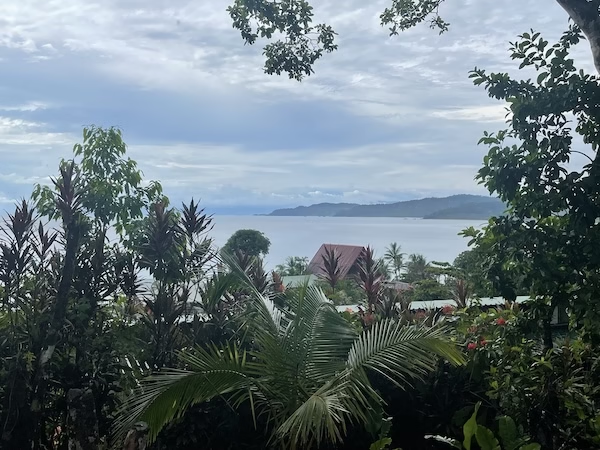
On one of the most fun, but also most stressful, aspects of travel is finding and booking places to stay. These days you have options ranging from dirt cheap hostel dorms to luxurious White Lotus style resorts. Thankfully, the internet is here to make finding accommodation easier.
Hostelworld is the go to app for finding hostels. For everything else, there’s Booking.com. If you book through either of the previous links, I’ll gain a small commission at no extra cost to you.
Visiting Corcovado National Park
The number one thing to do in Drake Bay and on the Osa Peninsula is obviously the marvelous Corcovado National Park. This park is probably the whole reason you came to Drake Bay in the first place. It’s worth braving a thunderstorm for.
We saw an intimidating number of animals during our relatively short time there. Squirrel monkeys catching and eating giant grasshoppers. A pack of coatis playing in the trees. The deadly venomous fer-de-lance snake coiled up in the leaves. And last but not least, a mother and baby tapir lounging in the underbrush along the beach. Those were just the highlights.
You can visit Corcovado National Park as a day trip, or you can spend the night. I would definitely consider staying in the park if and when I go back. As far as I know, park regulations require you visit with a guide. Our guide was a local fellow with a master’s degree in biology. While I do love wandering the jungle on my own, without a guide I think it would be all too easy to miss a lot of the animals, and possibly miss the trail. They are not very straightforward.
For a day trip, you’ll meet up with your guide on the beach and take another boat ride to the park. Based on the number of boats and tour groups milling around at the start, I worried we’d be crowded and annoyed. However, everyone seems to dissipate once you get to the jungle. You’ll spend the whole day walking. It’s hot, so bring water, sun screen etc. There’s usually a break for snacks at the middle of the tour.
Corcovado National Park is divided up into five sectors. Our tour spent most of the time in the Sirena sector. The official website is unclear whether guides are mandatory or just recommended, but we just arranged everything through our hostel. Otherwise, there are a number of tour operators in town. The tours to Corcovado National Park are not cheap, but I think the price is worth it. When else are you going to be able to visit one of the most biologically diverse places on the planet?
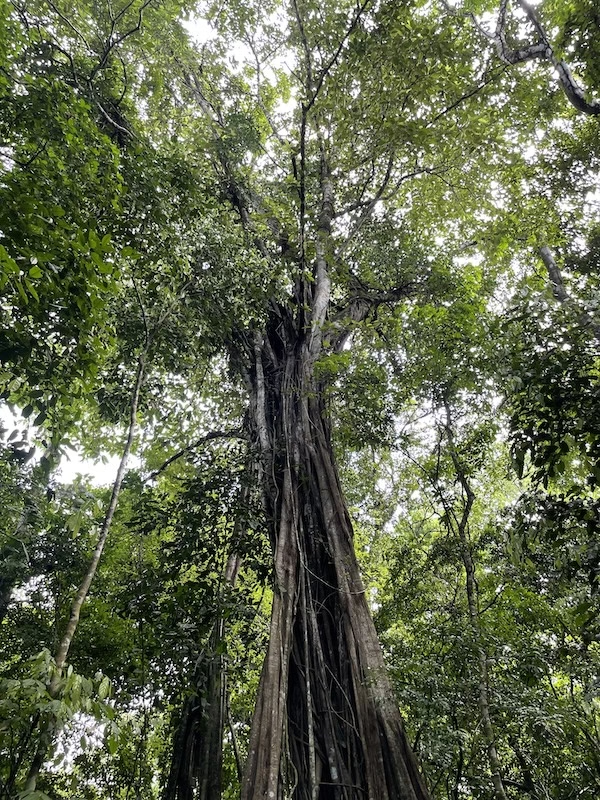
Things to Do in Drake Bay Besides Visiting Corcovado National Park
Aside from the national park, the town of Drake Bay itself doesn’t have a lot going on. That’s all part of the charm. The main attraction here is the nature and wildlife of the Osa Peninsula. Thankfully, there are a handful of other ways to Explore the Osa Peninsula’s wild nature from Drake Bay.
Some of us like to fly by the seat of our pants and not plan anything. Others crawl by the hem of our pants and meticulously plan every detail. If you’re a planner, I suggest using Get Your Guide to book tours. They’re generally cheaper than online alternatives and offer a wide range of activities. If you book through the following link, I’ll get a small commission at no cost to you and you’ll gain the satisfaction of supporting an independent travel blog. Click here to explore tours in Costa Rica.
Hike The Drake Bay Beach Trail
Just outside of town is a lovely little trail that follows the beach and provides some stunning views as well as opportunities for animal encounters. Sometimes terrifying animal encounters. The Drake Bay Beach trail is free to access and one of the best things to do in Drake Bay. It’s not as majestic as the national park, but it’ll give you a taste of Corcovado.
The trail officially goes to a beach called Playa Rincón, and further on into the national park. You can, of course, stop and turn around at any time, which you might want to do in the blazing tropical heat. You’ll pass some resorts, then some lush jungle and some gorgeous looking beaches. The rough currents mean they’re more looking beaches than swimming beaches, but they are beautiful.
You can find the Drake Bay beach trail just outside of town. Follow the curve of the bay south-west, past the beach crossing a small bridge. There’s a small restaurant further down, but bring food and water. And look out for monkeys.
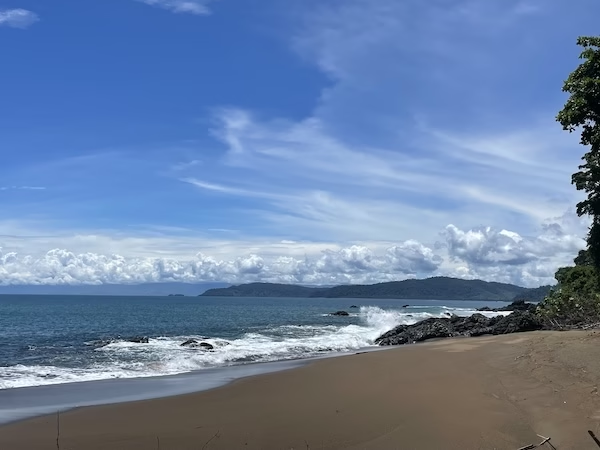
The Monkey Attack
A ruthless gang of White-Faced Capuchin monkeys patrols part of the Drake Bay trail. We’d met another traveler who’d been bit by one of them, so we’d been warned. Now I’m warning you.
As we were walking, sure enough, a crowd of about 12 monkeys suddenly burst out from the surrounding vegetation. They came towards us, barring their teeth and generally acting aggressive. So, we did what any self-respecting person would do and ran away.
Then, just when we thought we were safe, a German kid we’d come across made the mistake of opening a candy bar. The monkeys screeched and came after us again. I had to pick up a stick and shake it at them to keep them back. It started raining so we retreated to the protective zinc roof of what looked like some kind of picnic shelter.
We heard thuds as the monkeys jumped onto the roof. They didn’t come inside, but they reached their tiny demon hands beneath the eves and screeched at us in the rain. After a while, they got bored and left. A local Costa Rican guy was in the shelter with us, and he seemed rather amused at the sight of four gringos hiding away from a troop of monkeys.
Let him laugh. I’m not trying to get bit by a monkey while I’m traveling. There are two lessons I think we can all learn from this scenario. One: if you are attacked by monkeys, shake a stick at them so they at least keep their distance. Two: never feed wild animals. Those rough and tumble monkeys were obviously habituated to humans and attracted by our human food.
Thankfully, we didn’t have a similar situation with the crocodile lurking in the river just past the beach.
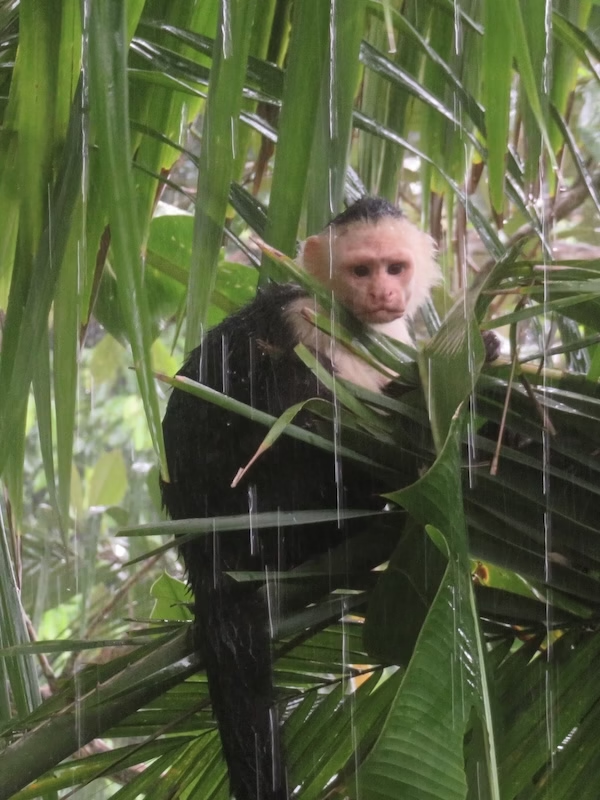
Hiking the Danta Trail
The rest of our nature experiences on the Osa Peninsula were far less scary. Apparently not having had enough jungle time, we arranged another hike in a private reserve called the Danta Trail. This reserve is located just outside of Corcovado National Park and shares much of the same plants and animals. However, while much of Corcovado is secondary growth forest, the Danta Trail is full of old growth trees.
We did a combination afternoon and evening tour. The guide was an excellent source of information, and we got to see some much more chill spider monkeys, as well as a wide variety of tropical birds. On the night tour, I achieved my long-time Costa Rica wildlife wish and finally got to see one of the famous red-eyed tree frogs.
We visited the Danta Trail on a tour arranged through our hostel.
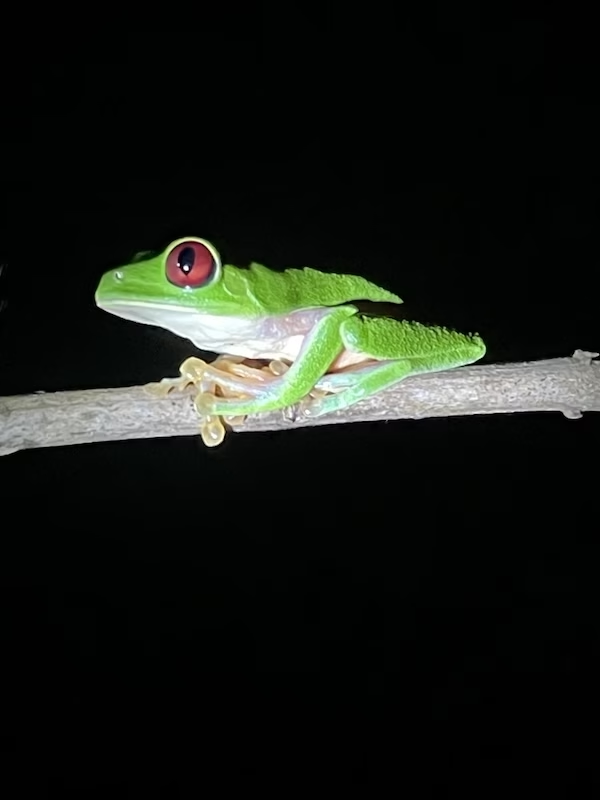
Snorkeling on Isla Caño
I have heard tell that Isla Caño, an island just off the coast of the Osa Peninsula, has some of the best snorkeling in all of Costa Rica. I cannot confirm this, since we didn’t do it. I was sick for part of our time in Drake Bay, and the price was a little more than we were able to swing, especially after shelling out for the Corcovado National Park Tour. Excuses, I know. However, this is on the list for next time.
Final Thoughts on Drake Bay and the Osa Peninsula
Costa Rica is a wonderful country, but a lot of it feels built up and a bit over-touristed. When you’ve grown tired of the Uvitas and Manuel Antonios, spending time in scruffy little Drake Bay is like a breath of fresh air. Despite existing almost exclusively for the sake of tourism, and being very much on the beaten path, Drake Bay still feels like an adventure at the edge of the world.
Of course, that could all change. There’s talk of the government paving the roads that head into town. This will obviously allow people much easier access to Drake Bay. It also might bring a wave of unwanted development. Thankfully, there are plenty of locals putting up the good fight and trying to convince the government to change its plans and keep those muddy, dirt roads as they are.
In the meantime, Drake Bay remains a charmingly shabby little travel outpost. The kind of place where the idea of eco-tourism doesn’t feel like a marketing ploy. And of course, the Corcovado National Park is an absolute treasure. It’s easily the best national park in all of Costa Rica.
I loved Drake Bay and the Osa Peninsula despite the difficulty getting there, despite the monkey attack and despite the high cost of tours. Take a chance on a real adventure and you might end up loving it, too.
Want to read more about Costa Rica? Check out our guide here: Come to Costa Rica: A Travel Guide to the Tourist Hotspot I Still Love
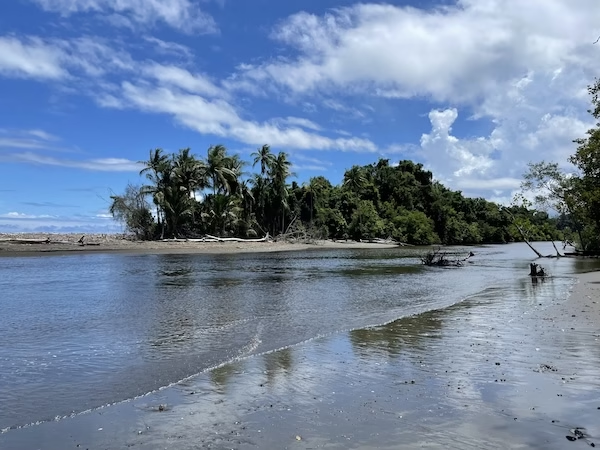
Useful Websites for Traveling Costa Rica
As much as we might long for the days when you could show up to a town with nothing more than a beat-up guidebook and a sense of adventure, today much of traveling involves being glued to our phones making bookings. I’ve compiled some helpful apps and websites below that at least help make those bookings more convenient so you can spend less time staring at your phone and more time exploring at your surroundings. Some of these sites are affiliate links that give me a small commission at no cost to you if you chose to book through them. All of them are sites I’ve used personally and have no problem recommending.
Just be sure to do your due diligence as much as possible. Only hire local guides and try as much as possible to stay in locally owned hotels and hostels so that your hard earned travel dollars actually go to support the local economies of the places you visit.
Booking.com is basically the world’s only hotel booking website. They have hotels, guesthouses and vacation rentals all over Costa Rica.
Hostelworld is the go-to site for booking hostels. If dorm rooms and shared bathrooms are your thing, you’ll find hostels all over Costa Rica.
Get Your Guide offers tours and activities all around the world. Unlike some other sites and apps that do the same thing, you can actually find some reasonably priced deals here.
Centro Coasting is a great website to look up bus routes and times throughout Central America. Schedules change regularly, and the site is sometimes not as up to date as you’d like. However, it’s a good resource to help give you an idea when the buses leave, or at least get you to the right terminal.

